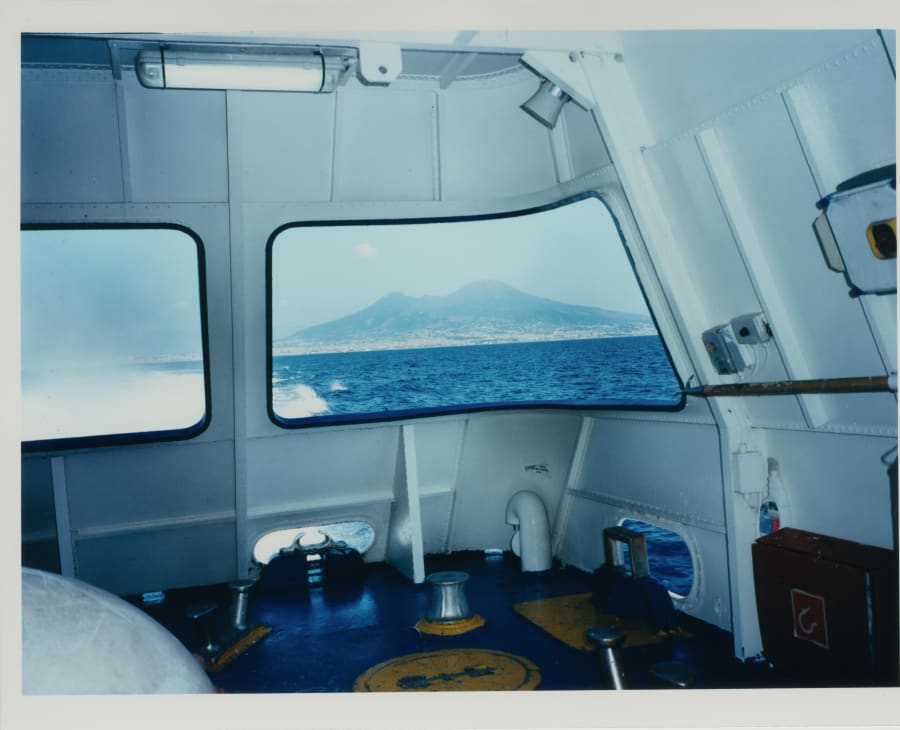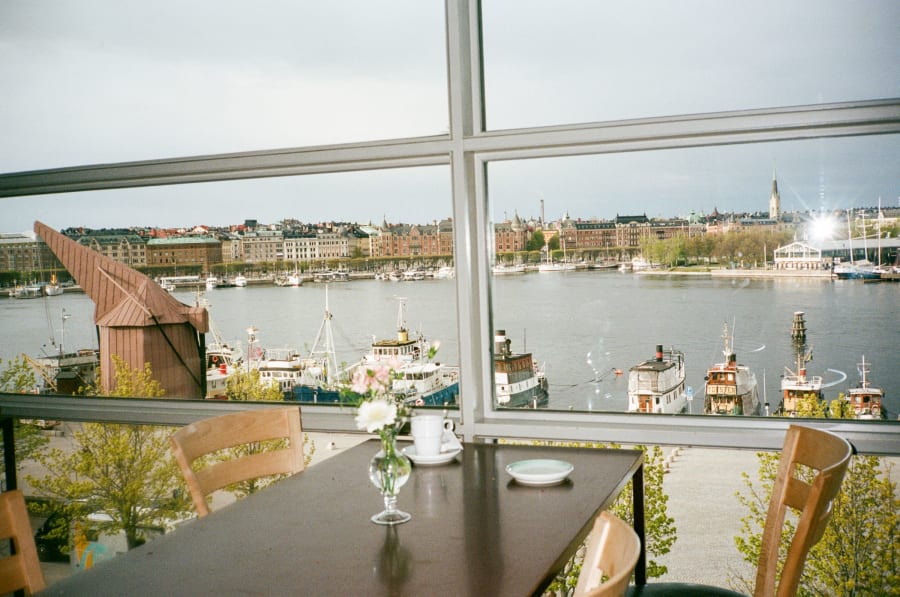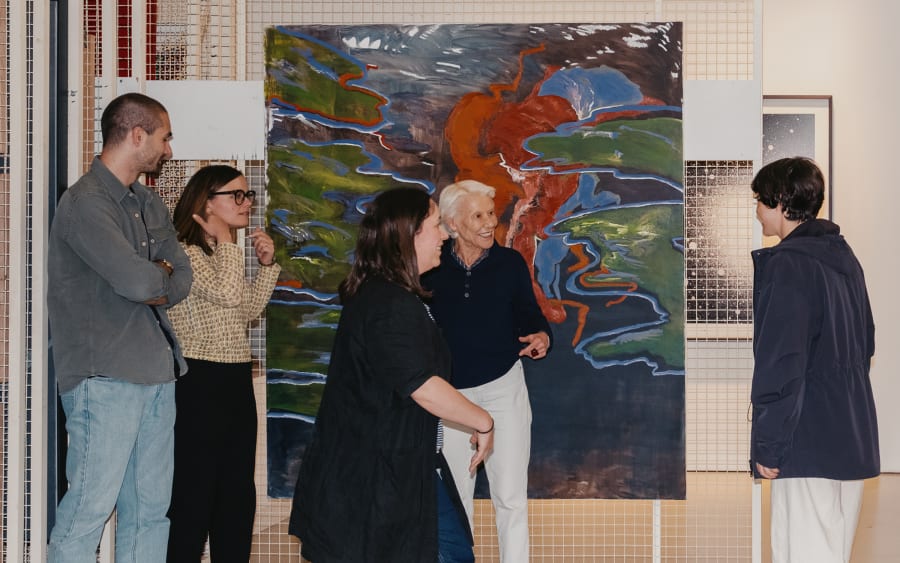They say that if you throw a stone in Ireland, you will hit a writer. But these days, you will just as easily hit a world-renowned visual artist, a subversive rap group, an Oscar-winning actor, or a prominent director. Authors such as Oscar Wilde, James Joyce, Edna O’Brien, Anne Enright, and many others have paved the way for the country’s current artistic boom, with creatives of all stripes, from Cillian Murphy to Hozier, flying the flag on the global stage. Its art world, too, is dense with talented individuals.
In the remote reaches of Ireland’s northwest, collaborative duo Ruth Clinton and Niamh Moriarty have been making visual art for over a decade. Both are originally from Dublin but moved away from the capital as rents began to rise and studio space became unaffordable. Their work engages strongly with Ireland, but pushes against idealized visions of the country, testing the possibility for creating ‘a new narrative identity for Ireland and the Irish diaspora.’
‘It’s looking critically at how the state has created a sense of so-called Irishness, the tropes and stereotypes and stories we tell ourselves about ourselves,’ says Clinton. The point is ‘to acknowledge our struggles, admit our complicities, crucially, and then build capacity for solidarity,’ Moriarty adds. At present, they are preparing work to show at EVA International, Ireland’s biennial of contemporary art, which takes place in the southwesterly city of Limerick. In two new video installations, they will examine ideas of land ownership over the centuries. Defunct barite mines in the Dartry Mountains, an upland plateau between counties Sligo and Leitrim, are one point of reference.
In Limerick, venues from fishmongers to office blocks prepare to welcome artists and art lovers for the biennial, which takes place from August 29 to October 26. Now in its 41st iteration, the vision from the beginning has been twofold: to introduce international contemporary art to regional Ireland and to create opportunities for artists to profile their practices outside the local scene.
This year’s guest program, ‘It Takes a Village’, is curated by Eszter Szakács, in collaboration with the EVA team. ‘The whole team tends to be involved in shaping up the exhibition,’ says EVA’s director, Matt Packer. ‘We’re working in a context like Limerick, which is not Berlin, it’s not Paris, or Brussels, it’s a very particular context in which to present artwork. You need the knowledge of the people on the ground here to provide an interface between international ambition and its application.’
A European art capital it may not be, but Limerick has more than its fair share of art infrastructure. ‘We’ve got a municipal art gallery; we’ve got the biennial; we’ve got an art school; we’ve got a large Kunstverein-style venue in Ormston House; we have performance and art project spaces like Starling and Spacecraft. If you compare that to towns in the UK with similar populations, some don’t have anything. I think there’s a lot to be proud of,’ says Packer. He adds that more infrastructural support is needed. ‘A lot of it happens through the extracurricular energy of the particular individuals involved.’
Packer is originally from Wales but has lived in Ireland for almost 20 years. Of late, he has noticed a ‘broader limelight’ being shone on the country’s music, television, and film – mediums ‘which are a bit more editorially palatable than the visual arts can ever be.’ As to whether visual art is having a moment, he feels its success has occurred behind the scenes.
‘It’s always been there. If you zoom in on individual practices, like Orla Barry, for instance – Orla’s CV is peppered with international opportunity yet still very much rooted and identified here in Ireland. I think there’s always been a kind of international connectivity, it just hasn’t been marketed and capitalized upon.’ Recently, he has observed ‘a greater confidence in being able to speak of Irish history in a way that feels progressive and internationalist at the same time.’
One Irish artist who has built a decidedly international career is Justin Fitzpatrick. Born in Dublin, he trained in London and is now based in Montargis, France. His work, such as his recent solo show, ‘A Musical Instrument’ at Kerlin Gallery in Dublin, draws on science, metaphysical poetry, mythologies, and an array of archetypal figures to explore human consciousness through the prism of biology. ‘I studied a lot of art history in London. You go through all the different major movements of painting, and I never felt like I saw Ireland come up in that art historical narrative,’ he says. ‘It was only more recently, in the last 10 years, that I started to look more into Irish art and found that actually we have an incredibly rich visual culture.’
Fitzpatrick’s work has drawn on illuminated manuscripts, the likes of which are central to Ireland’s artistic history. More recently he has become interested in the work of stained-glass artist and book illustrator Harry Clarke. And while, for the most part, he continues to position himself as an international artist, rather than foregrounding his national identity, some parts of his upbringing seep through regardless.
‘I’ve got a fixation on religion, even though I’m not religious at all. Ireland is so steeped in religious culture it permeates through Irish people, even if they distance themselves from it. It can be quite creative, even though there’s a negative charge to it. It feels like something to work against.’
Novelist Sara Baume, the author of A Line Made by Walking (2017), Seven Steeples (2022), and handiwork (2020), expresses a similar sentiment. ‘Lately, I’ve wondered whether there was any link between growing up in quite a religious society and the drive to rebel against the system that feeds good art,’ she says. Baume grew up in the 1980s and 90s, in the remote idyll of West Cork. A coastal region in the outer reaches of Ireland’s southwest, West Cork is known for its dramatic Atlantic landscapes, artistic communities, and has even drawn a handful of celebrities to its secluded environs (the likes of Saoirse Ronan, Jeremy Irons, and Paul Mescal all own homes there). While Baume spent some time in Dublin, she eventually returned to live and work in her home county.
‘What West Cork gives me is the landscape and the peace,’ she says. ‘I moved back in 2011. Part of that was because the rents were rising and there was an opportunity to live cheaply. That’s completely changed because the rents in rural Ireland are nearly as bad as the rents in Dublin, but I guess it’s still a boon to move to rural Ireland if you want to work as an artist.’
With countless contemporary authors making a splash globally, Baume sees Irish writing as having a moment. But she credits the success to ‘this strong tradition that leaves a residue, or leaves a door open. You have Joyce and Beckett and Yeats, and since then people have expected more and perhaps paid more attention to Irish literature. There’s a certain expectation set by those heavyweights that lasts for generations.’
Baume also credits things like independent publishers (Tramp Press, publishes her books), a strong journal culture (with renowned literary journals such as The Stinging Fly and The Dublin Review, as well as collaborative journals Holy Show, Profiles, and Paper Visual Art), a working and well-funded Arts Council, and schemes like the Basic Income for the Arts (currently in pilot form, but which pays selected artists a basic weekly income as they pursue their craft), as integral to the success of Irish arts.
Documentary filmmaker Sinéad O’Shea is the director of Blue Road: The Edna O’Brien Story (2024) which has become the highest-grossing independent Irish documentary at the Irish and UK box office. She says that without a concerted effort by the public body for film financing, Screen Ireland, she might not be where she is today.
‘When I started out 20 years ago, it was completely impossible. The money was very limited. I didn’t think it was very meritocratic. It was all about who you knew. All the decision makers were looking for young men to support. In the wake of the MeToo movement, there was a really considered effort by Screen Ireland to develop female filmmakers.’
O’Shea’s films, such as A Mother Brings Her Son to be Shot (2017) and Pray for Our Sinners (2022) touch on the themes of paramilitary forms of justice and Catholic church abuses. She agrees when asked if the negative aspects of Ireland might be useful in terms of creating art. ‘I suppose there are difficulties and paradoxes that encourage you to think in quite a creative way. [Irish people] are so used to thinking in a kind of doublespeak. It’s very good as a creative sport. Because so many things have been hidden, or unsaid, everything attains a kind of dark poetry. But I don’t think it’s fully a substitute for a functioning country.’
She believes Irish film is thriving, citing Mia Mullarkey, Sinéad O’Loughlin, Myrid Carten and Rioghnach Ní Ghrioghair as promising up-and-comers. When she was growing up, the idea that the industry here would be seen as a ‘global leader’ was unthinkable, she says.
‘I actually think this wave is very much only beginning,’ she adds. ‘I think there’s going to be an awful lot more talent making headlines over the coming years.’
Niamh Donnelly is a writer and critic based in Dublin. Her short fiction has appeared in Granta, The Dublin Review, Banshee, and elsewhere. A regular contributor to The Irish Times, her work can also be found in Business Plus Magazine, The Irish Independent, New York Magazine, the Financial Times, The Business Post, The Sunday Times, and many other publications. She has been shortlisted for five Irish Journalism Awards.
Caption for top image: Cork at dusk. Photography by Niamh Barry for Art Basel.


